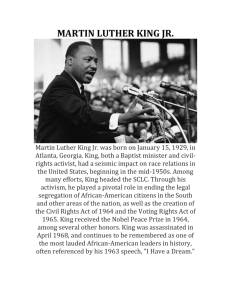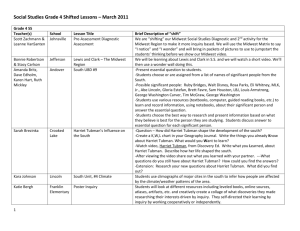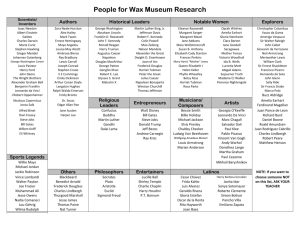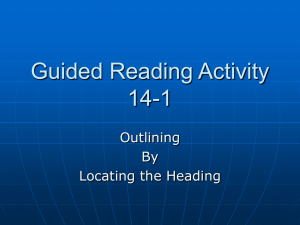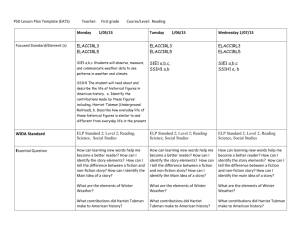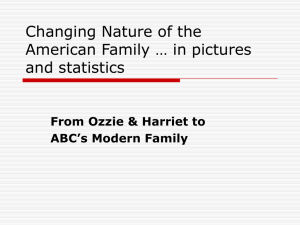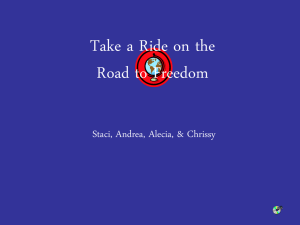Harriet Tubman
advertisement
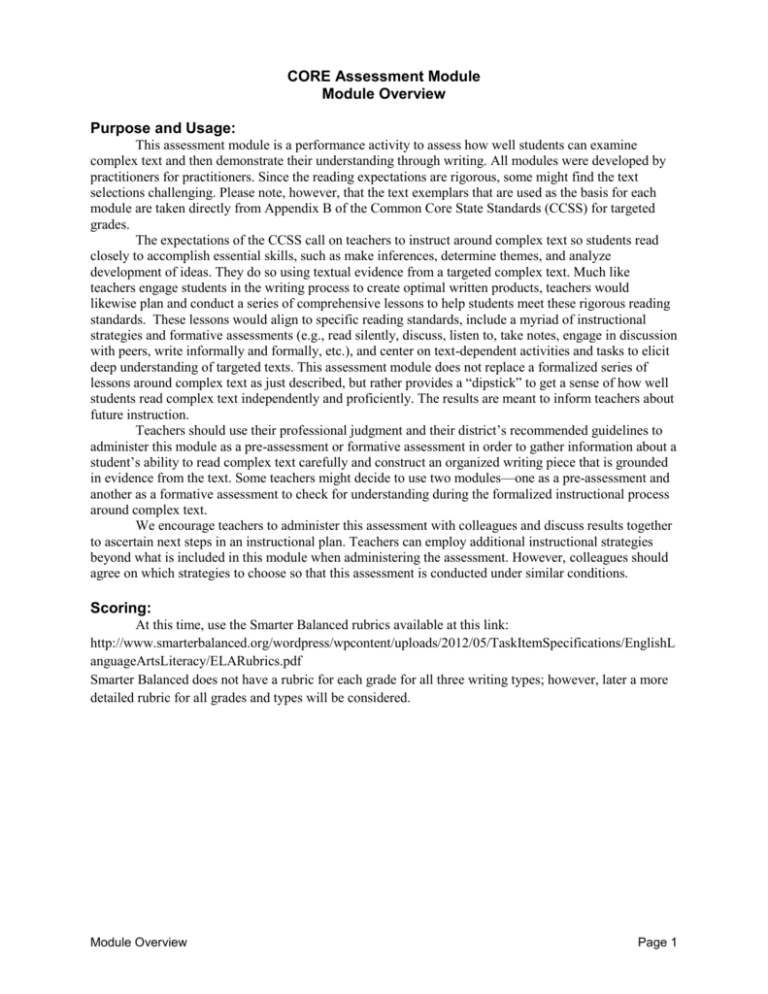
CORE Assessment Module Module Overview Purpose and Usage: This assessment module is a performance activity to assess how well students can examine complex text and then demonstrate their understanding through writing. All modules were developed by practitioners for practitioners. Since the reading expectations are rigorous, some might find the text selections challenging. Please note, however, that the text exemplars that are used as the basis for each module are taken directly from Appendix B of the Common Core State Standards (CCSS) for targeted grades. The expectations of the CCSS call on teachers to instruct around complex text so students read closely to accomplish essential skills, such as make inferences, determine themes, and analyze development of ideas. They do so using textual evidence from a targeted complex text. Much like teachers engage students in the writing process to create optimal written products, teachers would likewise plan and conduct a series of comprehensive lessons to help students meet these rigorous reading standards. These lessons would align to specific reading standards, include a myriad of instructional strategies and formative assessments (e.g., read silently, discuss, listen to, take notes, engage in discussion with peers, write informally and formally, etc.), and center on text-dependent activities and tasks to elicit deep understanding of targeted texts. This assessment module does not replace a formalized series of lessons around complex text as just described, but rather provides a “dipstick” to get a sense of how well students read complex text independently and proficiently. The results are meant to inform teachers about future instruction. Teachers should use their professional judgment and their district’s recommended guidelines to administer this module as a pre-assessment or formative assessment in order to gather information about a student’s ability to read complex text carefully and construct an organized writing piece that is grounded in evidence from the text. Some teachers might decide to use two modules—one as a pre-assessment and another as a formative assessment to check for understanding during the formalized instructional process around complex text. We encourage teachers to administer this assessment with colleagues and discuss results together to ascertain next steps in an instructional plan. Teachers can employ additional instructional strategies beyond what is included in this module when administering the assessment. However, colleagues should agree on which strategies to choose so that this assessment is conducted under similar conditions. Scoring: At this time, use the Smarter Balanced rubrics available at this link: http://www.smarterbalanced.org/wordpress/wpcontent/uploads/2012/05/TaskItemSpecifications/EnglishL anguageArtsLiteracy/ELARubrics.pdf Smarter Balanced does not have a rubric for each grade for all three writing types; however, later a more detailed rubric for all grades and types will be considered. Module Overview Page 1 Content Area Text Grade Level Target Area Common Core State Standards Smarter Balanced Assessment Claims Task Overview Module Components English Language Arts Harriet Tubman: Conductor on the Underground Railroad, by Ann Petry (excerpt) Grade 7 Text-Dependent Questions, Performance Writing Task (Informative/Explanatory) RI 7.1 Cite several pieces of textual evidence to support analysis of what the text says explicitly as well as inferences drawn from the text. RI 7.4 Determine the meaning of words and phrases as they are used in a text, including figurative, connotative, and technical meanings; analyze the impact of a specific word choice on meaning and tone. W 7.2 Write informative/explanatory texts to examine a topic and convey ideas, concepts, and information through the selection, organization, and analysis of relevant content. W 7.4. Produce clear and coherent writing in which the development, organization, and style are appropriate to task, purpose, and audience. W 7.9 Draw evidence from literary or informational texts to support analysis, reflection, and research. *SL 7.1 Engage effectively in a range of collaborative discussions (one-on-one, in groups, and teacher-led) with diverse partners on grade 7 topics, texts, and issues, building on others’ ideas and expressing their own clearly. Claim 1: Students can read closely and analytically to comprehend a range of increasingly complex literary and informational texts. Claim 2: Students can produce effective and well-grounded writing for a range of purposes and audiences. This assessment task will be completed in two parts. The prewriting/planning in part one will involve reading, note-taking, speaking and listening, and text-dependent questions. In part two, students will be asked to draft an informative/explanatory text. 1) Directions to Teacher 2) Text Passage 3) Text-Dependent Questions Graphic Organizer 4) Text-Dependent Questions Worksheet 5) Writing Task *Standard addressed but not explicitly assessed. Module Overview ELA Grade 7: Harriet Tubman Page 2 Harriet Tubman Directions to Teacher This Common Core-aligned ELA Performance Task can be given over one to two days depending on class schedules. The directions below outline the steps to follow for a two-day administration. Text: Petry, Ann. Harriet Tubman: Conductor on the Underground Railroad. New York: HarperCollins, 1983. (1955) From Chapter 3: “Six Years Old.” Materials: Harriet Tubman: Conductor on the Underground Railroad Text Passage Text-Dependent Questions Graphic Organizer Text-Dependent Questions Worksheet Writing Task Lined paper for writing Day 1 1. Reading (Approximately 10 minutes) Give students the Harriet Tubman: Conductor on the Underground Railroad Text Passage and instruct them to read it silently. 2. Note-Taking Around Text-Dependent Questions Graphic Organizer (Approximately 10–15 minutes) Hand out the Text-Dependent Questions Graphic Organizer, and ask students to reread the passage and complete the “My Response” and “Evidence From the Text” sections as directed in the graphic organizer. Encourage students to expand their thinking beyond their immediate responses to the questions. 3. Speaking/Listening Exercise (Approximately 20 minutes) In pairs or groups of three, give students time to discuss the questions on the Text-Dependent Questions Graphic Organizer and to add information to the “My Thoughts Now” section. a. Why was Harriet taught to look for the North Star? b. What was Harriet taught to say to white women and white men? Why was she taught to use this language? c. Who were the patrollers and why did the slaves whisper the word? ELA Grade 7: Harriet Tubman Page 3 4. Constructed-Response Items (Approximately 30 minutes) Hand out the Text-Dependent Questions Worksheet and ask students to individually write their responses to the questions on a separate sheet of lined paper. a. Word Meaning – In the paragraph 1, the author says that by the age of 6, Harriet “had unconsciously absorbed many kinds of knowledge, almost with the air she breathed.” What does this phrase mean in the context of the excerpt? b. Key Details – What words and phrases does the author use to illustrate the slaves’ reactions to the sound of galloping horses? What mood do the words create? c. Central Ideas – What two lessons was Harriet was taught? How are the lessons connected? Give evidence from the text to support your answer. d. Reasoning/Evaluation – Explain how Harriet comes to the realization that she is a slave. Cite evidence from the text to support your explanation. Day 2 5. Performance Task (Writing Prompt) (Approximately 50 minutes) Provide students with the writing prompt. Let them know the amount of time they have to respond to the prompt in writing. Encourage students to use their graphic organizer and/or constructed response questions to inform their writing. ELA Grade 7: Harriet Tubman Page 4 Harriet Tubman: Conductor on the Underground Railroad Text Passage By the time Harriet Ross was six years old, she had unconsciously absorbed many kinds of knowledge, almost with the air she breathed. She could not, for example, have said how or at what moment she knew that she was a slave. She knew that her brothers and sisters, her father and mother, and all the other people who lived in the quarter, men, women and children were slaves. She had been taught to say, “Yes, Missus,” “No, Missus,” to white women, “Yes, Mas’r,” “No, Mas’r” to white men. Or, “Yes, sah,” “No, sah.” At the same time someone had taught her where to look for the North Star, the star that stayed constant, not rising in the east and setting in the west as the other stars appeared to do; and told her that anyone walking toward the North could use that star as a guide. She knew about fear, too. Sometimes at night, or during the day, she heard the furious galloping of horses, not just one horse, several horses, thud of the hoofbeats along the road, jingle of harness. She saw the grown folks freeze into stillness, not moving, scarcely breathing, while they listened. She could not remember who first told her that those furious hoofbeats meant that patrollers were going in pursuit of a runaway. Only the slaves said patterollers, whispering the word. Petry, Ann. Harriet Tubman: Conductor on the Underground Railroad. New York: HarperCollins, 1983. (1955) From Chapter 3: “Six Years Old.” ELA Grade 7: Harriet Tubman Page 5 Student Name ______________________ Text-Dependent Questions Graphic Organizer Directions: After rereading the text, write answers to each question below in the “My Response” section. Support each response by recording textual evidence in the “Evidence From the Text” section. After you are given time to talk to a classmate and share ideas, complete the “My Thoughts Now” section based on your conversation. 1. Why was Harriet taught to look for the North Star? My Response Evidence From the Text My Thoughts Now 2. What was Harriet taught to say to white women and white men? Why was she taught to use this language? My Response Evidence From the Text My Thoughts Now ELA Grade 7: Harriet Tubman Page 6 Student Name ______________________ 3. Who were the patrollers and why did the slaves whisper the word? My Response Evidence From the Text My Thoughts Now ELA Grade 7: Harriet Tubman Page 7 Student Name ______________________ Text-Dependent Questions Worksheet Directions: Answer the questions below on a separate sheet of lined paper. You may use this sheet to make any notes or draft your response, but only your complete answers on a separate sheet of paper will be scored. You may refer to the reading passage and your graphic organizer to help you answer the questions. 1. In the paragraph 1, the author says that by the age of six, Harriet “had unconsciously absorbed many kinds of knowledge, almost with the air she breathed.” What does this phrase mean in the context of the excerpt? 2. What words and phrases does the author use to illustrate the slaves’ reactions to the sound of galloping horses? What mood do the words create? 3. What two lessons was Harriet taught? How are the lessons connected? Give evidence from the text to support your answer. 4. Explain how Harriet comes to the realization that she is a slave. Cite evidence from the text to support your explanation. ELA Grade 7: Harriet Tubman Page 8 Student Name ______________________ Harriet Tubman: Conductor on the Underground Railroad Writing Task Directions: Please respond to the prompt below in writing. You may use your graphic organizer and/or constructed response questions to inform your writing. Writing Prompt After reading the excerpt from Harriet Tubman: Conductor on the Underground Railroad, describe the factors that shaped Harriet’s understanding of slavery. Why are those factors significant? Use evidence from the text to support your explanation. Be Sure To: Provide a clear introduction. Support your points with evidence from the text, such as relevant facts, definitions, concrete details, and quotations. Use appropriate transitions. Use precise language and vocabulary. Establish and maintain a formal style. Provide a conclusion that supports your description. ELA Grade 7: Harriet Tubman Page 9

